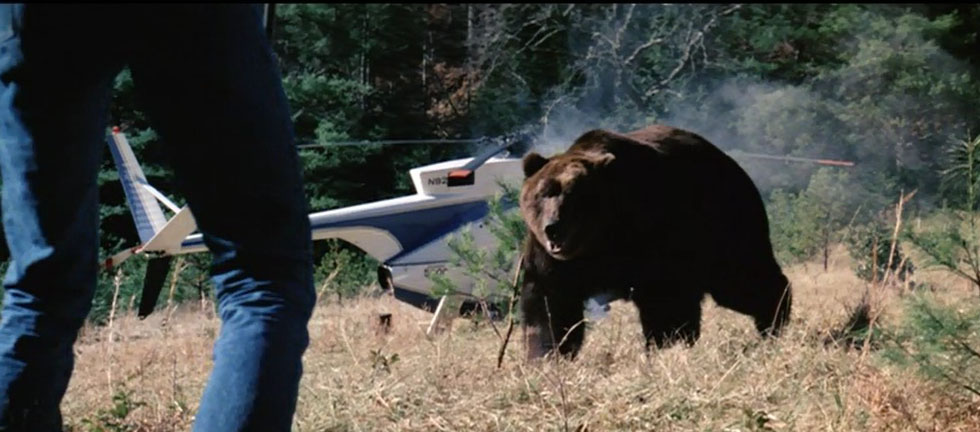Animal attacks are not uncommon things in the contemporary
world. Humans can sometimes cross paths with a wild animal at the wrong time
and place. Of course not all animals are intentionally setting out to harm
individuals, but there are those moments where they had it coming. Whether it
was due to their lack of awareness or just plain ignorance, certain animals
should not be domesticated because it's just shouldn't be done. As explored in
Steven Spielberg's ocean thriller Jaws (1975), the shark had proven to be a
formidable force that should only be observed from far distances. It made a lot
of people think twice about going back into the water. Smartly capitalizing on
the fad and everyone's deepest fears, a producer by the name of Edward L.
Montoro made this independent film focusing on a dangerous land animal. The
animal of choice for this feature was the grizzly bear. So now instead of scaring
the living life out of beach goers, Montoro wanted to make people fear their
own backyard. Well done Mr. Montoro.
 |
| "Why am I in a Jaws (1975) knock-off?!" |
Although the film has its own credited screenwriters, the
parallels between this movie and Jaws (1975) are all too familiar. Written by
Harvey Flaxman and David Sheldon, the script has few differences in its story.
Michael Kelly (Christopher George) is a ranger at the local park and the season
for backpackers and hikers has just kicked in. To his dismay a couple of
campers were mauled by a grizzly bear and now he's on the hunt with helicopter
pilot Don Stober (Andrew Prine) and nature boy Arthur Scott (Richard Jaeckel).
Breathing down Kelly's neck is park owner Charley Kittridge (Joe Dorsey), who
wants the bear gotten rid of. See the similarities in how the events reflect
what goes on in Jaws (1975)? The noticeable changes are that it deals with a
bear instead of a shark and it's on land and not at sea. There are even scenes
where after the campers are attacked, a posse of hunters go out to kill the
bear themselves. Even Kittridge becomes greedy and becomes okay with having the
publicity.
The minor changes within the story though deal with
Christopher George's character. Unlike the main character of Jaws (1975), Mike
Kelly is a single man who hasn't found the right woman in his life yet.
Co-starring in this film is another actor by the name of Joan McCall playing
Allison Corwin. She initially comes across like she could turn into Kelly's
love interest but then goes nowhere. From the start Corwin explained to Kelly
that she was trying to finish a project she was working on, but two thirds of
the way through she completely vanishes from sight never to be heard from
again. Something's a miss here. And McCall's character isn't the only one with
an unfinished thread. There are a few others, and doesn't resolve much in the
story. It's unbecoming that so much of the screenplay resembles another movie
only to not completely take what they've learned and apply it correctly. Why
bother introducing a character that adds nothing to anything?
The only true actors to come out unscathed is Christopher
George and "Teddy" the bear actor. Although much of his other
co-stars have been in several films like him, George is the only actor to try
and make his role his own. Christopher George is probably best known for
playing a role in the so-bad-it's-so-good film Pieces (1982). This feature
would be his next best. The rest of the acting by Andrew Prine and Richard Jaeckel
act passably but do not stand out from any other cast member. Andrew Prine
would take a minor roll Ronald F. Maxwell's epic of Gettysburg (1993) and
Richard Jaeckel would also play a minor role in the science fiction drama
Starman (1984). For animal actors, "Teddy" the portrayed grizzly bear
killer was quite a looker. In all honesty, the thought of having a real bear on
scene was not thought to be likely. Apparently they did have a real bear on set
though, and he is something to watch. There are some pretty serious injuries
that are filmed too but the actual mauling isn't too believable.
 |
| "Teddy" the bear actor |
The camerawork that goes with film is mostly doable. The
only time it's too unconvincing is when the camera represents the animal
attacks. The lens just moves too much to figure out everything. Other than
that, the wide panning shots by William L. Asman are visually pleasing. The
forest is a big place and the landscape is vast in its scope. The camera is
also used as the eyes of the grizzly which has it pushing through brush so as
to look like the viewer is the bear. That looks fairly accurate. Although Asman
has done cinematography, his main credit is as a camera operator to films like
The Rocketeer (1991) and Speed (1994). The music by Robert O. Ragland is also a
supportive element to the film. It's by no means anywhere close to as recognizable
as John Williams' music, but it has its moments. Sadly there's no main theme,
which could've helped the movie greatly. Ragland also made the score to both
The Fear (1995) and The Fear: Resurrection (1999). Hmmmmm okay.
Points Earned --> 6:10
No comments:
Post a Comment